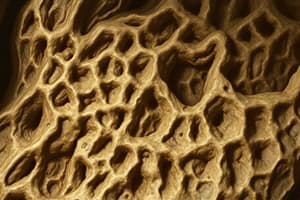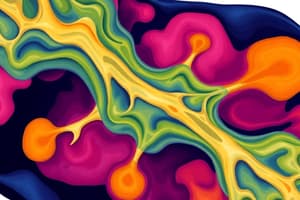Podcast
Questions and Answers
Which characteristic cell type is primarily associated with dense connective tissue?
Which characteristic cell type is primarily associated with dense connective tissue?
- Chondrocytes
- Osteocytes
- Fibroblasts (correct)
- Adipocytes
What is the primary function of cartilage?
What is the primary function of cartilage?
- Provides flexible support and shock absorption (correct)
- Connects muscles to bones
- Provides rigid support and protects internal organs
- Stores energy and insulates the body
Which type of cartilage is found in the human ear?
Which type of cartilage is found in the human ear?
- Non-elastic Cartilage
- Fibrocartilage
- Elastic Cartilage (correct)
- Hyaline Cartilage
Why is bone considered dense connective tissue?
Why is bone considered dense connective tissue?
Which type of cell is primarily involved in blood clotting?
Which type of cell is primarily involved in blood clotting?
Adipose tissue is primarily responsible for which of the following functions?
Adipose tissue is primarily responsible for which of the following functions?
What type of connective tissue contains chondrocytes in lacunae?
What type of connective tissue contains chondrocytes in lacunae?
Which type of cartilage typically has the highest amount of collagen?
Which type of cartilage typically has the highest amount of collagen?
What material is primarily found in the matrix of dense connective tissue?
What material is primarily found in the matrix of dense connective tissue?
Which type of connective tissue serves as a framework to support and protect internal organs?
Which type of connective tissue serves as a framework to support and protect internal organs?
Flashcards are hidden until you start studying
Study Notes
Dense/Fibrous Connective Tissue
- Features nuclei and fibers arranged in parallel rows for strength.
- Composed of ligaments that bind bones and tendons that connect muscles to bones.
- Found in the middle layer of the skin.
- Main cell types include fibroblasts and macrophages.
- Primarily consists of collagen fibers.
- Distributed irregularly in the skin, regularly in tendons and ligaments.
- Functions to provide a flexible and strong connection.
Cartilage
- Matrix is gum-like, providing flexibility and support.
- Contains chondrocytes located in lacunae within the matrix.
- Fiber types include elastin, collagen, and non-elastic reticular fibers, which are very thin.
- Types of cartilage include:
- Hyaline cartilage found at bone ends.
- Elastic cartilage located in ear structures.
- Non-elastic cartilage present in the nose.
- Additional cell types include chondroblasts.
- Varies in fiber composition: hyaline has few collagen, fibrocartilage has a large amount of collagen.
- Located in structures like shark skeletons, fetal bones, human ears, and intervertebral discs.
- Provides flexible support, shock absorption, and reduces friction in load-bearing areas.
Bone/Osseous Tissue
- Matrix is solid, primarily made of calcium carbonate.
- Contains a vascular system, including blood supply and nerves through Haversian canals.
- Cells include osteoblasts (build bone), osteocytes (maintain bone), and osteoclasts (break down bone).
- Contains collagen fibers among few elastic fibers.
- Found in vertebrate skeletons.
- Functions to protect internal organs and provide rigid support for muscle attachment.
Adipose Tissue
- Composed of adipocytes with large vacuoles for lipid storage.
- The nucleus and cytoplasm are located at the cell membrane's edge due to the large vacuole.
- Serves multiple purposes: insulation, cushioning of joints, organ protection, and energy storage.
- Contains very few fibers.
- Located in various adipose or fat tissue areas throughout the body.
Blood/Vascular Tissue
- A complex mixture of varied cell types suspended in liquid matrix known as plasma.
- Comprises erythrocytes (red blood cells) that transport oxygen, forming the majority of blood cells.
- Contains leukocytes (white blood cells) that protect against infections and clean the body of abnormal cells.
- Includes platelets that assist in blood clotting.
- Does not contain fibers.
- Found exclusively in blood, playing critical roles in transportation and immunity.
Studying That Suits You
Use AI to generate personalized quizzes and flashcards to suit your learning preferences.




